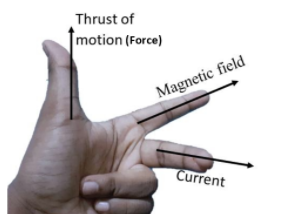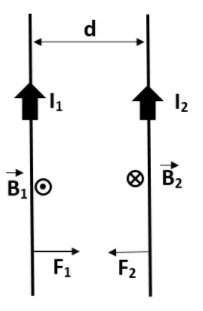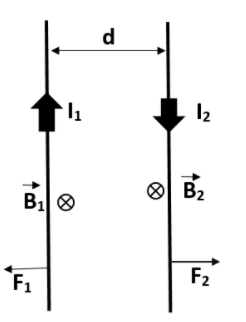
What is the nature of force between two parallel conductors carrying currents in the direction?
Answer
543k+ views
Hint: Using the concept of magnetic field and Biot-Savart's law, we can easily calculate the magnetic field and the force on the current carrying conductors. The direction of this force is given by Fleming’s left hand rule and magnitude is directly proportional to the currents on each conductor and inversely proportional to distance between them. Here, we will find the direction of this force and conclude whether they are attractive or repulsive.
Complete answer:
We must know that Fleming’s left hand rule gives the direction of force acting on a current carrying conductor. Here, the forefinger represents the direction of the field, the second finger represents that of current, and the thumb gives the direction of force. i.e.

Now, we will need to consider two cases for two parallel current carrying conductors.
(1) If the current in both conductors are in the same direction.
We will need to draw a diagram to get a clear idea about the particular situation.

Here, we have two parallel current carrying conductor, separated by a particular distance d, such that one of the conductors is carrying a current ${{I}_{1}}$ and the other is carrying ${{I}_{2}}$ , which are in same direction. The direction of magnetic force is indicated in the figure and is found using Fleming's left hand rule.
So, in this case two forces are acting towards each other. So we can say that they are attractive.
Therefore we can conclude that if the current in the two conductors placed parallel are in the same direction, the force acting on the will be experienced as attractive.
2) If the current in the two conductors are in the opposite direction.
We will need to draw a diagram to get a clear idea about the particular situation.

Here, we have two parallel current carrying conductor, separated by a particular distance d, such that one of the conductors is carrying a current ${{I}_{1}}$ and the other is carrying ${{I}_{2}}$ , but in opposite direction. The direction of magnetic force is indicated in the figure and is found using Fleming's left hand rule.
So, in this case two forces are acting opposite to each other. So we can say that they are repulsive.
Therefore we can conclude that if the current in the two conductors placed parallel are in the opposite direction, the force acting on the will be experienced as repulsive.
Note:
We have only discussed the direction of force experienced by the conductors in the above solution. The magnitude of this force is directly proportional to the current carried by both conductors. i.e. ${{I}_{1}}$ and ${{I}_{2}}$ . This force is also inversely proportional to the distance between these conductors. i.e. d. it is given by the formula,
${{F}_{21}}=\dfrac{{{\mu }_{0}}{{I}_{1}}{{I}_{2}}}{2\pi d}$
Where, ${{\mu }_{0}}$ is the permeability of vacuum.
Complete answer:
We must know that Fleming’s left hand rule gives the direction of force acting on a current carrying conductor. Here, the forefinger represents the direction of the field, the second finger represents that of current, and the thumb gives the direction of force. i.e.

Now, we will need to consider two cases for two parallel current carrying conductors.
(1) If the current in both conductors are in the same direction.
We will need to draw a diagram to get a clear idea about the particular situation.

Here, we have two parallel current carrying conductor, separated by a particular distance d, such that one of the conductors is carrying a current ${{I}_{1}}$ and the other is carrying ${{I}_{2}}$ , which are in same direction. The direction of magnetic force is indicated in the figure and is found using Fleming's left hand rule.
So, in this case two forces are acting towards each other. So we can say that they are attractive.
Therefore we can conclude that if the current in the two conductors placed parallel are in the same direction, the force acting on the will be experienced as attractive.
2) If the current in the two conductors are in the opposite direction.
We will need to draw a diagram to get a clear idea about the particular situation.

Here, we have two parallel current carrying conductor, separated by a particular distance d, such that one of the conductors is carrying a current ${{I}_{1}}$ and the other is carrying ${{I}_{2}}$ , but in opposite direction. The direction of magnetic force is indicated in the figure and is found using Fleming's left hand rule.
So, in this case two forces are acting opposite to each other. So we can say that they are repulsive.
Therefore we can conclude that if the current in the two conductors placed parallel are in the opposite direction, the force acting on the will be experienced as repulsive.
Note:
We have only discussed the direction of force experienced by the conductors in the above solution. The magnitude of this force is directly proportional to the current carried by both conductors. i.e. ${{I}_{1}}$ and ${{I}_{2}}$ . This force is also inversely proportional to the distance between these conductors. i.e. d. it is given by the formula,
${{F}_{21}}=\dfrac{{{\mu }_{0}}{{I}_{1}}{{I}_{2}}}{2\pi d}$
Where, ${{\mu }_{0}}$ is the permeability of vacuum.
Recently Updated Pages
Why are manures considered better than fertilizers class 11 biology CBSE

Find the coordinates of the midpoint of the line segment class 11 maths CBSE

Distinguish between static friction limiting friction class 11 physics CBSE

The Chairman of the constituent Assembly was A Jawaharlal class 11 social science CBSE

The first National Commission on Labour NCL submitted class 11 social science CBSE

Number of all subshell of n + l 7 is A 4 B 5 C 6 D class 11 chemistry CBSE

Trending doubts
What is meant by exothermic and endothermic reactions class 11 chemistry CBSE

1 Quintal is equal to a 110 kg b 10 kg c 100kg d 1000 class 11 physics CBSE

What are Quantum numbers Explain the quantum number class 11 chemistry CBSE

What is periodicity class 11 chemistry CBSE

What is a periderm How does periderm formation take class 11 biology CBSE

Mention the basic forces in nature class 11 physics CBSE




